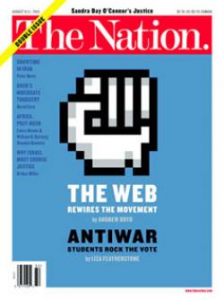 [Originally appeared as the cover article in the August 4, 2003 edition of The Nation.]
[Originally appeared as the cover article in the August 4, 2003 edition of The Nation.]
From MoveOn to meetup.com, the net is facilitating a new citizen insurgency
The Battle in Seattle brought to the world’s attention a new global resistance movement that was not only made possible by the Internet but, as Naomi Klein has deftly pointed out, was shaped in its image. Sharing the Internet’s architecture of interconnected hubs and spokes, the new movement was a coalition of coalitions, a decentralized network of campaigns “intricately and tightly linked to one another.”
The net allows large mobilizations to unfold with minimal bureaucracy and hierarchy. “Forced consensus and labored manifestoes are fading into the background,” Klein wrote in 2000, “replaced instead by a culture of constant, loosely structured, and sometimes compulsive information-swapping.”
But if Seattle was the birth of this new kind of organizing, last February 15’s global peace demonstration marked its coming of age. That day, some 400,000 people turned out onto the streets of New York to protest Bush’s impending war on Iraq, and close to 10 million more turned out in cities across the globe. It was arguably the single largest day of protest in world history; the New York Times dubbed its participants “the other superpower.”
The day sent a clear message about the grassroots organizing power of the net: It enabled the antiwar movement to turn out its base quickly and cheaply, do an end run around corporate-controlled media and reach into the politically disaffected American mainstream. The coming months and years will test how deeply the new movement can tap this potential, and to what extent “nets roots” organizing will be adopted by more established political players, liberal and conservative alike.
Given this deepening embrace of the net by movement culture, it is fitting that the website of United for Peace and Justice (UFPJ), the national coalition at the heart of the February 15 protest, not only anchored the massive mobilization but preceded the existence of the organization and helped it to coalesce. In December, UFPJ did not have an office or a paid staff. The website, however, was already a one-stop shop for the many disparate strands of the peace movement. Launched the previous October, it was getting hundreds of thousands of hits a day.
“At the beginning, we had almost no money, not even enough to do a major mailing,” says L.A. Kauffman, a staff organizer for UFPJ. The Internet allowed UFPJ to start serious organizing with only $5,000 to $10,000. “We pulled off a demo in five weeks that would normally take five or six months,” she says.
Providing one place for UFPJ’s hundreds of member organizations to list their actions and report their activities, the website quickly became an antiwar hub. Organizers put campaign materials and action kits online, and 15,000 copies of the February 15 flier were downloaded. People could easily find and plug into local peace activities in their towns or states, and time local events to coordinate with broader efforts. In the end, 793 protests happened around the world on that day, including more than 200 across the United States and Canada, with paid organizers put to work only on the biggest, in New York. All the others were self-organized by UFPJ affiliates–local church, labor and peace groups who used the website to facilitate their own coordination.
When I asked Leda Dederich, UFPJ’s web director, where her organization would be without the Internet, she said, “Mostly, we wouldn’t be.”



